Dracaena home care guide: planting, watering, fertilizing and other activities
Today, the object of our attention will be dracaena, home care, watering, transplanting, pruning and other procedures necessary for growing this ornamental plant.
Rules for keeping dracaena at home
Southern guest - dracaena brings the smell of the rainforest to the house, making it a unique aura. In total, there are more than 60 species of dracaena, which differ in height, as well as in color, size and width of leaf plates.
Common to all varieties of dracaena are:
- very dense trunk wood;
- rosette of leaves that fall off with age, exposing the trunk.
When growing dracaena at home, it is very important to create optimal growing conditions for it as close as possible to what it has in its natural environment. In the room, you need to maintain the required temperature regime, the specified parameters of air humidity, the duration and intensity of lighting.
Temperature regime
At first glance, it may seem that dracaena, like a southern plant, loves high air temperatures, but this is a big mistake. She feels fine in the temperature range from +5 to +25 degrees.
The optimal winter temperature for it is +15 degrees, and in the rest of the year it requires +20 degrees. It has been established in practice that +11 degrees of dracaena tolerates more easily for a short period than heat of 30 degrees or more.
When ventilating the premises, drafts should be avoided, because they have a negative effect on the dragon tree. In the warm summer period, it is allowed to take out a pot with a dracaena to the loggia or to the courtyard. However, even at the same time, you need to make sure that it is not blown by the wind.
Lighting requirement
It is better to place a flowerpot with dracaena on the windowsills of the eastern or western windows. If the windows of the apartment face the north side, then the dracaena will lack light, it will grow slowly. You can correct the situation by installing artificial lighting.
In the case when the windows of the apartment are facing south, the dracaena can get sunburn. Here, too, you can find a way out by making artificial shading of the flower. There should be as much light as possible, but it should be diffused.
Dracaena species with variegated leaves need more intense lighting. With insufficient lighting, they lose their decorative effect. In winter, they must be supplemented by lighting, lengthening the length of daylight hours.
Air humidity
Dracaena does not tolerate dry air. With insufficient moisture, the tips of the leaves dry, wither, and then fall off. In the room, the air is greatly dried by heating radiators, so you should try to place the flower pot at a distance of 1.5 meters from them.
To maintain humidity in the summer, the leaves of the culture are sprayed with a spray bottle twice a day. In addition, containers with water can be installed next to the pot, the water in them will evaporate and humidify the air. For spraying, use settled water at room temperature.
In winter, the humidity can be increased by hanging wet towels on the radiators.
Important! Periodically dracaena needs to be bathed in the shower.This procedure will not only add moisture, but also eliminate the dust that has settled on the leaves.
Types of dracaena and features of care, depending on the type
Not all types of dracaena are suitable for growing at home. Below are the varieties that are popular in the potting culture.
Table 1. Classification of the plant.
| Name | Description |
| Sander | A very cute evergreen that looks a lot like bamboo. The plant does not grow more than 1 meter, and its leaves can be 25 cm long. The shape of the leaves is lanceolate, their width is 3.5 cm. This species does not require any special care. It can grow without additional humidification of the air in the apartment, it easily takes root in water. |
| Godsef | The species is represented by a low shrub, which has many twigs and leathery oval leaves. The color of the leaf blades is light green with white spots, and their size is no more than 10 cm. In good conditions, it sometimes blooms at home. The flowers are small, yellow-green, endowed with a pleasant aroma. |
| Bent | This species comes from Madagascar. The plant is very beautiful, has a bare trunk with a bunch of leaves on the crown. The leaves are arched, strongly curved, up to 16 cm long. It blooms extremely rarely at home. Inflorescence is a panicle composed of small white flowers. |
| Bordered or Marginata | The height of this plant can be up to 3 meters, and the length of its leaves is 0.7 meters. The color of the leaf blades is intense green with brownish edges. There is a longitudinal yellow stripe in the middle of the leaf. This type is often used for interior design. Marginata responds very well to spraying the leaves with a spray bottle, especially in the warm season. |
| Dragon tree | It grows wild in the Canary Islands. The species is represented by a tree 10 meters high, but at home it rarely exceeds 1.5 meters in height. The leaves are gray, 0.6 meters long, have thorns at the tips. In good light conditions, the edges of the leaf plates may turn slightly red, which gives the flower an additional decorative effect. |
| Mix | The species combines a list of features characteristic of other types of dracaena. It arose as a result of crossing, therefore, there are significant differences between individual representatives of this species. Representatives of this species may have wide or narrow leaves, have or not have longitudinal stripes on the leaves. The color of the leaves also differs. The mix grows very poorly in direct sunlight. |
| Deremskaya | This species is characterized by the darkest leaf color of all representatives of the Dracaena genus. In a potted culture, the flower looks very attractive, experts say that this species is capable of disinfecting the air in the room. The leaves are wide enough, similar in shape to an egg or a spear. The leaves have yellow or white stripes. |
| Fragrant | This species is most popular in the pot culture. At home, a tree grows, no more than 2 meters high. Its leaves are slightly curved, hanging down. This species never blooms in the house. The species can be easily propagated by seed. |
Important! Dracaena species with variegated leaf color require more intensity of illumination. So that they do not lose their decorative effect, they, especially in winter, are provided with additional lighting using fluorescent lamps. The dark leaves of some dracaena species indicate their ability to grow with some shade.
How to properly care for a plant
This pseudo-palm tree looks good in spacious offices or apartment rooms. But when growing such flowers, various technological problems can arise. Therefore, it is very important to study the recommendations for caring for dracaena, and then start growing it in your apartment.
Watering
Dracaena is a very moisture-loving plant, it needs to be irrigated often and abundantly. In the summer, you need to water the pots with dracaena every other day.At this time, she is actively building up her vegetative mass and for this she needs a lot of moisture. Water used for irrigation needs to be boiled or defended for 2 days. The irrigation water temperature should be +22 degrees.
With the arrival of October, the number of waterings is reduced, and from December to March, it is enough to water the flower once a week. In no case should waterlogging of the soil in the pot be allowed. As a result, the roots will not be able to fully breathe, they will begin to rot, and the plant will die.
Attention! Dracaena species with wide leaves consume more moisture than narrow-leaved forms. The amount and rate of watering for them should be increased.
Top dressing
In the process of vital activity, the dracaena consumes various nutrients from the soil of the pot. If you do not replenish the nutritional balance, then over time the nutrients in the soil will run out, the plant will not be able to develop normally. This explains the need for top dressing.
Top dressing begins in spring during the period of active plant growth. Fertilizing compositions are introduced into the soil of the pot every ten days. And in winter, when the flower falls into a dormant state, it is enough to feed it once a month.
Ready-made commercial mixtures intended for evergreen flowers are used as fertilizers. The variegated forms of dracaena should be fed with special fertilizers for ornamental plants.
Fertilizers for foliar feeding are also on sale. They are dissolved in water and then the crown of the flower is sprayed. The color of the leaves after this treatment becomes more intense and shiny. This treatment also reduces the stress of the plant after transplanting.
Pruning
Dracaena care is a mustincludes cropping... This operation is performed to give the plant a neat appearance or for its further reproduction. Pruning should be done in spring when sap flow is at its maximum. This operation is performed on plants that have a height of 30 cm or more.
The procedure is performed as follows:
- choose a place from which new shoots will grow later;
- with a sharpened knife, cut off the top of the flower, 12-15 cm long;
- rearrange the flower in a darkened place;
- before the appearance of new leaves, dracaena is not watered, but only sprayed.
Pinching and shaping a bush
At home, the dracaena grows with its top, and the lower stem is more and more bare. After 1.5-2 years, the leaves naturally die off and fall off, leaving ugly scars on the trunk. With the help of pinching, you can achieve branching of the dracaena and obtain a pretty crown.
We buy in the store an already branched dracaena, which has 2-3 branches. In the future, you can separately shape each twig to get a picturesque tree.
On the trunk of the dracaena, dormant buds are located in a spiral, from which new shoots can potentially be obtained. Thus, by shortening the top to a certain length, the plants can be made more compact.
With the help of a pinch, you can also remove broken parts of the plant or areas affected by diseases and pests.
Protection against diseases and pests
At home, dracaena rarely suffers from pests, but sometimes it can be affected by spider mites and other parasites, indicated below:
- shield;
- aphid;
- mealybug;
- thrips.
Worms and scale insects are capable of infecting both the leaves and roots of the flower. As a result of pests, dracaena may dry out and fall off the leaves, and in some cases the plant may die.
In the fight against insects, wiping the leaves with soapy water is used. In addition, you can spray the plants with commercial insecticides. After a two-week interval, the treatment should be duplicated.
In the process of growing dracaena, it can get sick with non-communicable diseases that arise due to improper care of it.
Table 2. Problems arising from errors in growing technology.
| Problems | The reasons |
| Yellowing of leaves | Every 2 years, the dracaena sheds old leaves and in their place, then new leaves grow. If the leaves of the lower tier of a flower turn yellow, this is a normal natural process. If young leaves turn yellow, this indicates existing irrigation irregularities. During the growing process, moisture must be controlled. Short-term drying of a three-centimeter soil layer is allowed. |
| Drying of the tips of the leaves | The reason for this is the lack of moisture in the ambient air. To avoid this, you should regularly spray the crown of the flower, especially in the summer. Another reason for the drying out of leaves is soil salinity, which can also occur due to an overdose of fertilizers. Dracaena roots get burned, because of this, it may die. Transplanting the dracaena into another pot with new soil solves this problem. |
| Rotting stem |
This ailment is caused by a bacterial infection. Rotting begins at the top of the stem, after which the infection spreads in the form of moist dark spots over the entire leaf surface. The central trunk is rotting from the inside. It is impossible to save a plant from such a disease; it dies. The reasons that led to such a disease may be:
|
| Falling leaves |
Premature leaf fall is also quite common in dracaena. This is usually seen in older plants that are poorly cared for. Treatment for this ailment involves spraying dracaena every ten days with special means. Falling leaves can occur for the following reasons:
|
How to propagate dracaena
Dracaena propagation can be done in several ways. At home, the following breeding methods are more often chosen:
- seed;
- apical cuttings;
- dividing cuttings;
- air layering.
Seed propagation is considered the most difficult. However, with this option, the likelihood of the plant flowering increases. All types of breeding are best done in the spring.
Seeds
Dracaena, which have a green leaf color, are often propagated by the seed method. For this, dracaena seeds are used, which have bloomed at home.
Before sowing, the seed is kept for a day in a solution of a growth stimulator. The soil for planting should be prepared ahead of time, fill peat pots with it. One seed is planted in each pot, then watered and covered with a film to reduce moisture evaporation. The room temperature is maintained at +25 degrees.
Seedlings will appear in 45-55 days. The film is immediately removed, and the seedlings begin to water and fertilize monthly. After waiting for the seedlings to grow up to 6 cm, they are transplanted into pots and placed in a permanent place.
By dividing the stem
This method is identical to the version with reproduction by apical shoots. It differs only in that the long stem is divided with a knife into several parts, 10-13 cm long.
A piece of the stem is cut on one side under the bud and stuck into the ground. To prevent moisture loss, the cutting is covered with a jar and placed in a warm place. This mini-greenhouse should be kept out of direct sunlight and kept moist soil. With the emergence of shoots on the cuttings, the jar is removed and the leaves are sprayed with clean water.
Important! The knife with which the cuttings are cut must be sharpened well. The cut must be smooth and even, otherwise rotting of the cutting may occur.
Apical cuttings
The top of the flower is cut off and immediately planted in a substrate prepared in advance. There is an additional benefit from this method - new shoots grow from the buds of the plant, improving the decorative effect of the flower.
There is a second method of propagation by apical cuttings. Its essence lies in the fact that the cut stalk is slightly dried in the air for 2 hours, and then it is lowered into a glass with water and a tablet of activated carbon dissolved in it. The water is changed daily until the roots grow back from the cutting. Then it is planted in a permanent pot.
Air layering
This method is used on young plants from which it is very problematic to obtain cuttings. The work is carried out in the following sequence:
- a place is marked on the trunk from where the roots will grow and a light transverse incision is made;
- so that the incision does not overgrow, a match is inserted into it;
- the place of the incision is wrapped with sphagnum moss and a plastic bag;
- moss under the bag is regularly moistened with a spray bottle;
- after a while, roots will sprout through the moss;
- after waiting for the formation of roots, the film is removed, and the finished seedling is cut off from the mother plant;
- the separated seedling is planted in the ground.
Flower transplant
Potted dracaena needs replanting every 3 years. This is due to the fact that the roots of the plant develop rapidly and over time they become cramped in the volume of the pot. When transplanting, always use a larger pot.
To understand when to transplant dracaena, you need to measure its growth rate. A slower growth rate indicates that it is time to replant the flower. Plants with a height of about 40 cm are transplanted into a pot with a diameter of at least 15 cm.
The transplant is carried out with utmost care, because the roots of the dracaena are very fragile. Tall pots are more suitable. A two-centimeter layer of pebbles is laid on their bottom for drainage. The rest of the pot is filled with a special soil mixture for palm plants.
The transplant is carried out by the transshipment method. Its essence lies in the fact that a flower with an earthen lump is transferred into a new, more voluminous pot and all the voids are filled with soil mixture. The soil in the pot is slightly compacted and abundantly watered with a stimulant solution for better rooting.
Features of care, depending on the season
In indoor conditions, dracaena can live from 5 to 15 years. On the territory of Russia, the dracaena cannot survive in the open air, since it requires room temperature and high humidity. Caring for this plant in summer is different from caring for winter.
Summer care
In the summer, flower care consists of the following list:
- Lighting. Flower pots are installed on windowsills where there is maximum illumination by diffused rays of the sun. To achieve this, you need to install a filter made of translucent material in the path of the rays.
- Irrigation. Watering should be regular, each time you should start moistening when the top three-centimeter layer of soil dries up. Watering frequency is every other day.
- Air humidity control. To raise the humidity level, you should additionally moisten the leaves with a spray bottle.
- Top dressing. Replenish the balance of nutrients in the pot every 10 days.
Winter care
With the onset of cold weather in dracaena, all life processes and growth are inhibited. At this time, he does not need a lot of watering and fertilizing, and maintaining the required temperature comes to the fore. It is not advisable to leave the flower on the windowsill, since temperature drops are observed there, and the heating battery drains the air greatly.
In winter, you must adhere to the following recommendations:
- Irrigation. The number of waterings is gradually reduced to 1-2 per week.
- Top dressing. They are not carried out at all in the winter period, or they do one feeding procedure for a month.
- Lighting. The potted dracaena is placed against the wall opposite the window. There will be enough light for the winter content and there will be no temperature difference.
Important! In winter, they do not breed dracaena, since active sap flow is required for successful rooting.
Here, perhaps, is the entire list of basic measures for caring for an exotic dracaena at home. By doing them, you can achieve the fragrance of this indoor flower, and if you are lucky, you can observe its flowering. Follow our recommendations and you will succeed.
Related videos:



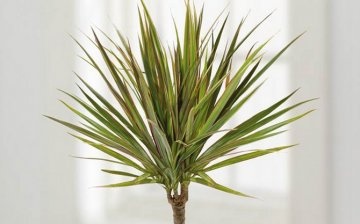

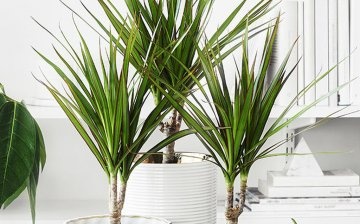
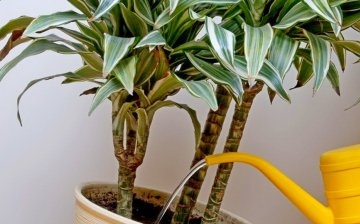




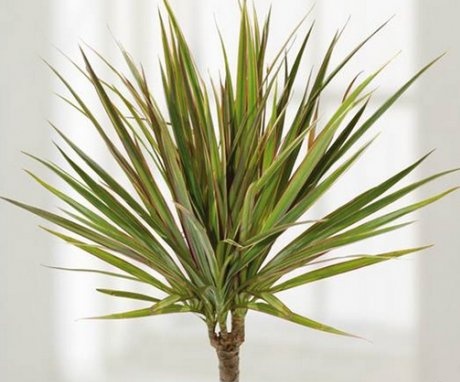
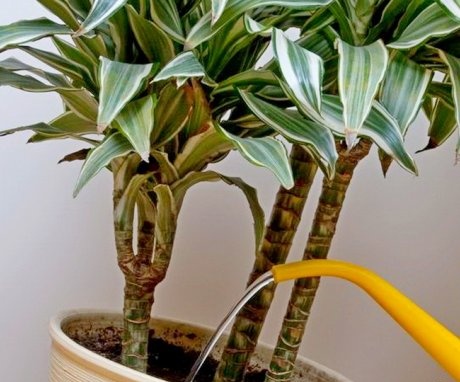
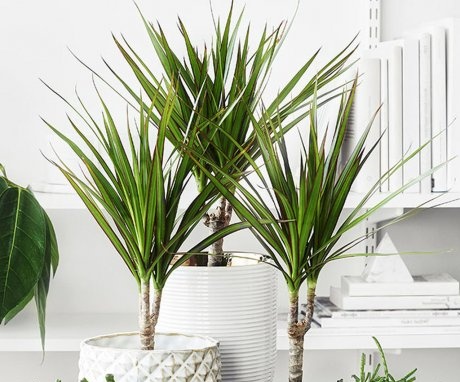
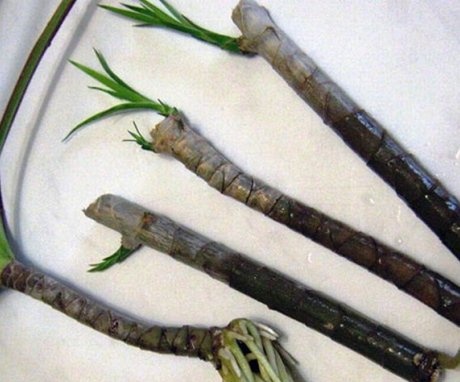
Our home dracaena is not well taken care of. We water it irregularly, we spray it also rarely. With top dressing, things are even worse, and there is a flower by the window facing northwest. Once, the dracaena did not water in the summer for more than two months, however, we put a bucket of water next to it. The plant has passed this test.
Absolutely unpretentious flower, I certainly do not arrange tests for him. Watering and spraying regularly as the soil dries up, but I have not used fertilizers yet. I will definitely try. In general, I noticed that indoor humidity is one of the most important points for this type of dracaena.
Dracaena is usually not very capricious, only it grows very slowly, but this is not a problem, because not everyone needs her great growth. In general, the problem is only to multiply it, it will not always work.